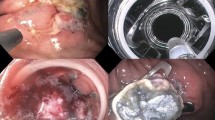Abstract
Background
Carcinoid tumors of the duodenum are rare, and the most effective treatment for duodenal carcinoid tumors remains debatable. Because carcinoid tumors of the gastrointestinal tract tend to spread to the submucosal layer even during the early stages of the disease, the possibility of tumor seeding in the vertical margin of the tumor cannot be eliminated by conventional endoscopic mucosal resection (EMR). In addition, because the duodenal wall is thinner than the gastric wall, EMR performed for duodenal lesions may be associated with a high risk of accidental perforation. In this article, we introduce a minimally invasive endoscopic full-thickness resection technique after laparoscopic repair for the local resection of duodenal carcinoid tumors.
Methods
Under general anesthesia, after the duodenum was mobilized laparoscopically, the duodenal serosa at the site of the lesion was suctioned under laparoscopic observation, and full-thickness resection of the duodenum was performed using a cap-fitted endoscope, i.e., EMR-c, without injecting hypertonic saline-epinephrine. The sample was retrieved endoscopically after resection. After confirming that the full-thickness resection of the duodenal wall with enough surgical margins was achieved and that there was no active bleeding, the wound was sutured by the laparoscopic hand-suturing technique.
Results
We have performed this surgical procedure in two cases of duodenal carcinoid tumor. The mean operation time was 116 ± 14 minutes, and the estimated blood loss was 2.5 ± 0.5 ml. The postoperative courses were uneventful in both cases.
Conclusions
The technique of endoscopic full-thickness resection of gastrointestinal tract under laparoscopic observation is a safe, simple, and can be radical surgical procedure for a small duodenal carcinoid tumor. This surgical procedure may be applicable in the case of other gastrointestinal tumors.






Similar content being viewed by others
References
Modlin IM, Lye KD, Kidd M (2003) A 5-decade analysis of 13, 715 carcinoid tumors. Cancer 97:934–959
Yamamoto C, Aoyagi K, Suekane H, Iida M, Hizawa K, Kuwano Y, Nakamura S, Fujishima M (1997) Carcinoid tumors of the duodenum: report of three cases treated by endoscopic resection. Endoscopy 29:218–221
Yoshikane H, Goto H, Niwa Y, Matsui M, Ohashi S, Suzuki T, Hamajima E, Hayakawa T (1998) Endoscopic resection of small duodenal carcinoid tumors with strip biopsy technique. Gastrointest Endosc 47:466–470
Alberti-Flor JJ, Hernandez ME, Ferrer JP (1993) Endoscopic polypectomy of a large duodenal carcinoid. Gastrointest Endosc 39:853–854
Milsom JW, Bohm B, Hammerhofer KA, Fazio V, Steiger E, Elson P (1998) A prospective, randomized trial comparing laparoscopic versus conventional techniques in colorectal cancer surgery: a preliminary report. J Am Coll Surg 187:46–54
Sato T, Fukunaga T, Ohyama S, Ueno M, Oya M, Yamamoto J, Saiura A, Yamaguchi T, Muto T, Kato Y (2005) Endoscopic total layer resection with laparoscopic sentinel node dissection and defect closure for duodenal carcinoid. Hepatogastroenterology 52:678–679
Hiki N, Yamamoto Y, Fukunaga T, Yamaguchi T, Nunobe S, Tokunaga M, Miki A, Ohyama S, Seto Y (2008) Laparoscopic and endoscopic cooperative surgery for gastrointestinal stromal tumor dissection. Surg Endosc 22:1729–1735
Mullen JT, Wang H, Yao JC, Lee JH, Perrier ND, Pisters PW, Lee JE, Evans DB (2005) Carcinoid tumors of the duodenum. Surgery 138:971–977
Burke AP, Sobin LH, Federspiel BH, Shekitka KM, Helwig EB (1990) Carcinoid tumors of the duodenum. A clinicopathologic study of 99 cases. Arch Pathol Lab Med 114:700–704
Toyonaga T, Nakamura K, Araki Y, Shimura H, Tanaka M (1998) Laparoscopic treatment of duodenal carcinoid tumor. Wedge resection of the duodenal bulb under endoscopic control. Surg Endosc 12:1085–1087
Bowers SP, Smith CD (2003) Laparoscopic resection of posterior duodenal bulb carcinoid tumor. Am Surg 69:792–795
Suzuki H, Ikeda K (2001) Endoscopic mucosal resection and full thickness resection with complete defect closure for early gastrointestinal malignancies. Endoscopy 33:437–439
Author information
Authors and Affiliations
Corresponding author
Rights and permissions
About this article
Cite this article
Tsujimoto, H., Ichikura, T., Nagao, S. et al. Minimally invasive surgery for resection of duodenal carcinoid tumors: endoscopic full-thickness resection under laparoscopic observation. Surg Endosc 24, 471–475 (2010). https://doi.org/10.1007/s00464-009-0574-4
Received:
Revised:
Accepted:
Published:
Issue Date:
DOI: https://doi.org/10.1007/s00464-009-0574-4




